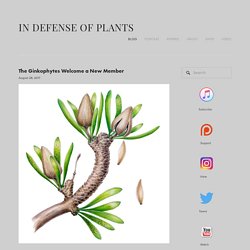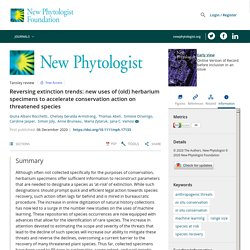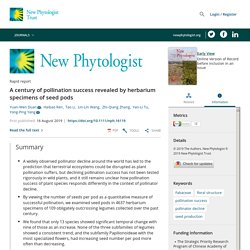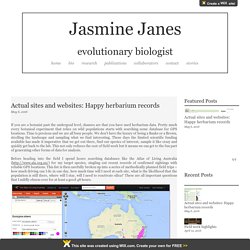

The Ginkophytes Welcome a New Member — In Defense of Plants. The paleobotanical team responsible for their discovery and analysis determined that these were in fact seed-bearing cupules of a long-extinct Ginkgophyte, which they have named Umaltolepis.

Previous discoveries have alluded to this as well, however, their exact morphology in relation to the entire organism has not always been clear. These new discoveries have revealed that the cupules (seed-bearing organs) themselves were borne on a stalk that sat at the tips of short shoots, very similar to the shoots of modern Ginkgo. They opened along four distinct slits, giving the structure an umbrella-like appearance. The seeds themselves were likely wind dispersed, however, it is not entirely clear how fertilization would have been achieved. Based on similar analyses, it is very likely that this species was wind pollinated.
Reversing extinction trends: new uses of (old) herbarium specimens to accelerate conservation action on threatened species - Albani Rocchetti. ‘…leaves laid up in a book of several plants. kept dry, which preserve colour however, and look very finely, better than any Herball.’

(Samuel Pepys’ Diary, 5 November 1665) 1 Introduction Current estimates that 39% of plant species are at risk of extinction (Antonelli et al., 2020) require rapid responses to reverse these trends and optimize efforts towards species recovery. This estimate stems from the International Union for Conservation of Nature (IUCN), which provides what is widely recognized as the most comprehensive listing of species at risk of global extinction in its IUCN Red List of Threatened Species (IUCN, 2017).
The process of correctly assessing a taxon’s extinction risk requires data on range extent, population size, and population trends over time (IUCN, 2019) and plant natural history collections (NHCs) can be very useful sources of such information (Carrington et al., 2017; Nic Lughadha et al., 2018). 2 Conservation action – recognizing what to protect. American Journal of Botany.
Complex migration history is revealed by genetic diversity of tomato samples collected in Italy during the eighteenth and nineteenth centuries. To shed light on the history of the spread of tomato in Europe, the draft genomes of two S. lycopersicum (formerly Lycopersicon esculentum) samples stored in PORUN were investigated.

Detailed analysis of herbarium cards, including handwritten labels and notes, yielded insights into the significance of the PORUN collection samples within their historical and scientific context. The older sequenced sample belongs to the Cirillo Collection, a famous private herbarium from the eighteenth century. Cirillo’s studies focused both on wild plants and on plants cultivated in his garden13,14. The herbarium bears one of Cirillo’s handwritten cards15, confirming that the specimen is one of the oldest herbarium tomato samples preserved in Italy. A century of pollination success revealed by herbarium specimens of seed pods - Duan - Corresponding Author E-mail address: duanyw@mail.kib.ac.cn Key Laboratory for Plant Diversity and Biogeography of East Asia, The Germplasm Bank of Wild Species, Institute of Tibetan Plateau Research at Kunming, Kunming Institute of Botany, Chinese Academy of Sciences, Kunming, 650201 China These authors contributed equally to this work.

Authors for correspondence: Pollen transfer dynamics. Pollen on Stigma. Petal Anatomy. Info on Indian crop plant: horsegram (Macrotyloma uniflorum) Using herbarium specimens to find populations. Before Collecting: Using herbaria to find where to look for plants. If you are a botanist past the undergrad level, chances are that you have used herbarium data.

Pretty much every botanical experiment that relies on wild populations starts with searching some database for GPS locations. Time is precious and we are all busy people. We don’t have the luxury of being a Banks or a Brown, strolling the landscape and sampling what we find interesting. These days the limited scientific funding available has made it imperative that we get out there, find our species of interest, sample it like crazy and quickly get back to the lab. This not only reduces the cost of field work but it means we can get to the fun part of generating other forms of data for analysis. Before heading into the field I spend hours searching databases like the Atlas of Living Australia ( for my target species, singling out recent records of confirmed sightings with reliable GPS locations.
The value of having such databases available to researchers is, well, invaluable. Digitization can enhance researcher diversity. Using associated taxa data. How Kew’s wood experts solve crimes. Medical Herbarium. *Corresponding Author: Satya SS Narina, Department of Biology, Virginia State University, Petersburg, Virginia.

Abstract Collection of information on medicinally useful plants or organisms by creating publicly accessible herbaria 1) to explore and continue including medicinally important exotic and native species from various geographical locations on the earth 2) to communicate their role in health and nutrition, is useful for both agriculture diversification, and research 3) in training and educating future generations for awareness to keep up to date with valuable imprints of our ancient discoveries through digitization and 4) to encourage new and applied research in health science.
A medical herbarium facility is necessary in every district or county and a small herbarium facility in every organization including elementary school to house the plants of their region. Keywords: Medical Herbarium; Salvia Aethiopis; S. Multicaulis; S.